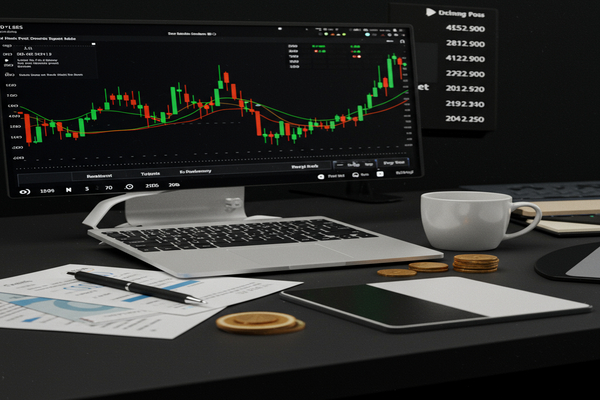
Big banks posted quarters driven by fees from dealmaking and trading, and markets reacted with a mix of optimism and caution. The immediate impact showed stronger trading revenue and higher fee income that lifted bank stocks. In the short term investors cheered higher profitability and resumed confidence in growth. Over the long term the results underscore renewed reliance on corporate activity and market volatility as profit drivers while raising questions about consumer savings and nonbank credit risks. The story matters globally because capital markets in the US, Europe, and Asia power deal flow. Compared with recent quieter years the summer was unusually busy for M&A and trading.
Big banks post fee-fueled quarters
Major US banks reported results that beat expectations, led by robust trading and corporate finance activity. Wells Fargo (NYSE:WFC) led the group with a 7.2% jump after it raised its profitability target. That move signals to investors that the bank expects growth after regulators removed a seven year asset cap in June. Goldman Sachs (NYSE:GS), JPMorgan (NYSE:JPM), and Citi (NYSE:C) also topped revenue and profit forecasts as clients pursued acquisitions and capital markets work.
Executives described a rare alignment of opportunity and execution. Goldman’s chief executive said CEOs felt now was the time to make strategic moves. JPMorgan’s finance chief called it the busiest summer in years for announced M&A. Those comments matter because fees from underwriting, advisory mandates, and trading are more volatile than loan income, but they can lift near-term returns significantly when deal flow is strong.
Management teams also flagged caution. JPMorgan’s leadership warned about potential weak spots in the credit chain tied to newer nonbank lenders. The collapse of a subprime auto lender is being treated as a signal that other exposures may surface when economic conditions deteriorate. At the same time consumer behavior showed resilience. Spending remained robust even as personal savings were a touch lower than expected in the quarter.
AI cloud deals widen the chip race
Chipmakers felt the market’s reweighting after Oracle (NYSE:ORCL) said it will deploy 50,000 AMD (NASDAQ:AMD) powered GPUs next year and scale further after that. The news lifted AMD shares early in the session before they settled to a close up 0.8 percent. Nvidia (NASDAQ:NVDA) shares fell 4.4 percent and Broadcom (NASDAQ:AVGO) closed down 3.5 percent on the same day.
The announcement matters now because cloud providers are placing large, public bets that influence vendor share and enterprise adoption. Oracle’s plan marks the first public AI supercluster using the new MI450 chips. That gives AMD momentum in a market long dominated by Nvidia. Investors are treating the development as confirmation that multiple suppliers can coexist as enterprise demand for generative AI and large scale training grows.
Still, Nvidia retains a dominant position in high performance AI chips. The market reaction shows investors are weighing competition and supply choices. For chipmakers and cloud operators the near-term signal is increased procurement flexibility. Over time this could translate to more competitive pricing and diversified architectures in data centers worldwide.
Market moves and risk signals
The S&P 500 closed down 0.2 percent in the session even as bank stocks rallied. That split captures a common dynamic: pockets of strength can coexist with broader market caution. Traders have been active and corporate clients have been using the moment to execute deals. Those flows boosted fee revenue for the banks that reported.
At the same time leadership warned that credit problems often reveal themselves only as conditions worsen. JPMorgan’s chief executive used a stark metaphor to suggest that one failure may indicate more to come among newer nonbank lenders. Credit deterioration can be slow to appear in headline metrics and sharp once it arrives. Investors should note the timing of these comments. Banks reported now and their guidance will set the tone for the next reporting cycle.
In addition to credit risks, executives highlighted investor exuberance in public markets spurred by AI investments. That perception can feed higher valuations and increase volatility if growth expectations change. Short term the market is pricing active dealmaking and trading. Longer term the questions are how sustainable fee levels are and which credit exposures will be tested in a downturn.
Consumer and corporate moves reshape product bets
Retailers and consumer companies are expanding product strategies to chase faster growing categories. Kellanova (NASDAQ:K) said Pop-Tarts Protein will debut in November with 10 grams of protein per serving in three flavors. The move is part of a broader protein push by big food companies that is reshaping product portfolios and marketing. PepsiCo (NASDAQ:PEP) told investors it has several protein innovations in the pipeline, including a Doritos product and a bottled Starbucks (NASDAQ:SBUX) coffee drink. Analysts estimate protein packed food and drink could grow from roughly $67 billion in 2023 to about $100 billion by 2030.
Those shifts matter to both retailers and suppliers because they change shelf mix, margin profiles, and advertising priorities. Consumers who prioritize protein include fitness oriented buyers and those using new weight management therapies. For food companies the category offers higher growth potential than some legacy snack lines.
Meanwhile other corporate developments added to market noise. Walmart (NYSE:WMT) announced a tie up with OpenAI to enable conversational shopping features so customers can plan meals and check out through ChatGPT based interfaces. General Motors (NYSE:GM) took a $1.6 billion charge on its EV business and said it will curtail manufacturing capacity as demand softens. Those decisions matter in different ways. Walmart’s move signals faster tech adoption in retail. GM’s charge underscores how capital intensive the electric vehicle transition remains and how quickly companies must recalibrate production when demand shifts.
The session combined encouraging signs of corporate activity and market-driven fees with reminders of structural risks in credit and capital intensive sectors. For investors and corporate managers today’s results highlight the immediate payoff from dealmaking and AI related investment while stressing the need to watch consumer savings trends and nonbank credit exposures over the coming quarters.












